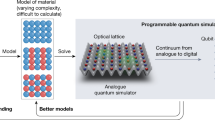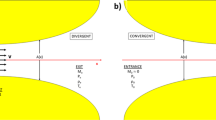Abstract
The paper considers fundamental limitations that impede the growth of performance of supercomputers based on silicon transistors and do not allow satisfying the needs of developing numerical weather and climate prediction models. A brief review of studies dealing with the development of quantum computing algorithms and with the creation of real quantum computers is provided. The shift from pure science to engineering solutions is observed. The leaders of the computer industry set the goal of creating a general-purpose quantum computer in the next few years. It is proved that the applicability of quantum computations and quantum computers for solving the problems of numerical weather and climate prediction should be preliminarily studied and assessed.
Similar content being viewed by others
References
A. I. Bedritskii, R. M. Vil’fand, D. B. Kiktev, and G. S. Rivin, “Roshydromet Supercomputer Technologies for Numerical Weather Prediction,” Meteorol. Gidrol., No. 7 (2017) [Russ. Meteorol. Hydrol., No. 7, 42 (2017)].
E. M. Volodin, V. Ya. Galin, A. S. Gritsun, et al., Mathematical Modeling of the Earth System, Ed. by N. G. Yakovlev (MAKS Press, Moscow, 2016) [in Russian].
L. D. Landau and E. M. Lifshits, Quantum Mechanics (Nonrelativistic Theory), 3rd ed., Vol. III: Theoretical Physics (Nauka, Moscow, 1974) [in Russian].
Yu. I. Manin, The Computable and the Noncomputable (Sovetskoe Radio, Moscow, 1980) [in Russian].
G. S. Rivin, I. A. Rozinkina, R. M. Vil’fand, et al., “The COSMO-Ru System of Nonhydrostatic Mesoscale Short-range Weather Forecasting of the Hydrometcenter of Russia: The Second Stage of Implementation and Development,” Meteorol. Gidrol., No. 6 (2015) [Russ. Meteorol. Hydrol., No. 6, 40 (2015)].
I. A. Rozinkina, E. D. Astakhova, T. Ya. Ponomareva, et al., “A Technology of the Operational Production of Global Weather Forecasts for 1-10 days Based on the T169L31 Model (with a 60-70 km Resolution) Using the New Supercomputer System of WMC Moscow,” Trudy Gidromettsentra Rossii, No. 346 (2011) [in Russian].
Website of ECMWF with Skill Scores of Forecasts of Leading Meteorological Centers, https://www.ecmwf.int/en/forecasts/quality-our-forecasts.
Website of COSMO Consortium, http://cosmo-model.org/.
Website of the WMO Working Group on Numerical Experimentation with the Table of Plans at NWP Centers with Global Forecasting Systems, http://wgne.meteoinfo.ru/nwp-systems-wgne-table/.
Website of Supercomputer Ranking, http://www.top500.org/.
A Page of the IBM Website Dealing with Quantum Computing, http://research.ibm.com/ibm-q/.
M. A. Tolstykh, Global Semi-Lagrangian Numerical Weather Prediction Model (OAO FOP, Moscow, Obninsk, 2010) [in Russian].
M. A. Tolstykh, J.-F. Geleyn, E. M. Volodin, et al., “Development of the Multiscale Version of the SL-AV Global Atmosphere Model,” Meteorol. Gidrol., No. 6 (2015) [Russ. Meteorol. Hydrol., No. 6, 40 (2015)].
M. A. Tolstykh and A. V. Frolov, “Some Current Problems in Numerical Weather Prediction,” Izv. Akad. Nauk, Fiz. Atmos. Okeana, No. 3, 41 (2005) [Izv., Atmos. Oceanic Phys., No. 3, 41 (2005)].
A. V. Frolov, “Medium-term Hydrodynamic Weather Forecast with a Spectral Atmospheric Model,” Meteorol. Gidrol., No. 11 (1994) [Russ. Meteorol. Hydrol., No. 11 (1994)].
A. V. Frolov, E. D. Astakhova, I. A. Rozinkina, et al., “Practical Predictability of Meteorological Variables with the Global Spectral Model at the Hydrometeorological Center of Russia,” Meteorol. Gidrol., No. 5 (2004) [Russ. Meteorol. Hydrol., No. 5 (2004)].
A. V. Frolov and V. I. Tsvetkov, “Uniform Approximation of Geophysical Fields on a Sphere by Trigonometric Polynomials,” Dokl. Akad. Nauk, No. 4, 408 (2006) [Dokl. Earth Sci., No. 4, 408 (2006)].
A. V. Frolov and V. I. Tsvetkov, “On Expansion of Analytical Functions in Ultraspherical Polynomials on the Sphere,” Meteorol. Gidrol., No. 9 (2009) [Russ. Meteorol. Hydrol., No. 9, 34 (2009)].
A. Arakawa and C.-M. Wu, “A Unified Representation of Deep Moist Convection in Numerical Modeling of the Atmosphere. Part I,” J. Atmos. Sci., 70 (2013).
M. Baldauf, A. Seifert, J. Forstner, et al., “Operational Convective-scale Numerical Weather Prediction with the COSMO Model: Description and Sensitivities,” Mon. Wea. Rev., 139 (2011).
P. Bauer, A. Thorpe and G. Brunet, “The Quiet Revolution of Numerical Weather Prediction,” Nature, 525 (2015).
C. H. Bennett, “Time/Space Trade-offs for Reversftle Computation,” SIAM J. Computing, No. 4, 18 (1989).
H. Bernien, S. Schwartz, A. Keesling, et al., Probing Many-body Dynamics on a 51-atom Quantum Simulator, https://arxiv.org/pdf/1707.04344.pdf.
I. A. Boutle, J. E. Eyre, and A. P. Lock, “Seamless Stratocumulus Simulation across the Turbulent Gray Zone,” Mon. Wea. Rev., 142 (2014).
D. Castelvecchi, “Quantum Computers Ready to Leap out of the Lab,” Nature, 541 (2017).
A. Childs and W. van Dam, “Quantum Algorithms for Algebraic Problems,” Rev. Mod. Phys., 82 (2010).
D. Deutsch, “Quantum Theory, the Church-Turing Principle and the Universal Quantum Computer,” Proc. Roy. Soc. London, Ser. A, 400 (1985).
J. Dudhia, “A History of Mesoscale Model Development,” Asia-Pacific J. Atmos. Sci., No. 1, 50 (2014).
R. P. Feynman, “Simulating Physics with Computers,” Int. J. Theor. Phys., No. 6/7, 21 (1982).
M. Hawkins, “Complex Supercomputer Upgrade Completed,” ECMWF Newsletter, No. 151 (2017).
S. Y. Hong and J. Dudhia, “Next-generation Numerical Weather Prediction: Bridging Parameterization, Explicit Clouds, and Large Eddies,” Bull. Amer. Meteorol. Soc., 93 (2012).
R. Landauer, “Irreversibility and Heat Generation in the Computing Process,” IBM J. Res. Dev., 5 (1961).
MetOffice Science Strategy: 2016-2021. Delivering Science with Impact (MetOffice, 2015), http://www.metoffice.gov.uk/research/overview.
A. Montanaro, “Quantum Algorithms: An Overview,” npj Quantum Information, 2 (2016).
National Centers for Environmental Prediction Strategic Plan 2015-2019. Version 4, February 27 (NCEP, 2015), http:www.ncep.noaa.gov/director/strategic_plan/strategic_plan.pdf.
Numerical Techniques for Global Atmospheric Models, Ed. by P. H. Lauritzen, C. Jablonowski, M. A. Taylor, and R. D. Nair, Lecture Notes in Computational Science and Engineering, 80 (2011).
Seam less Prediction of the Earth System: From Minutes to Months, Ed. by G. Brunet, S. Jones, and P. Ruti, WMO, No. 1156 (WMO, 2015).
H. H. Shin and S.-Y. Hong, “Analysis of Resolved and Parameterized Vertical Transports in Convective Boundary Layers at Gray-zone Resolutions,” J. Atmos. Sci., 70 (2013).
P. W. Shor, “Polynomial-time Algorithms for Prime Factorization and Discrete Logarithms on a Quantum Computer,” SIAM J. Computing, No. 5, 26 (1997).
A. J. Simmons and A. Hollingsworth, “Some Aspects of the Improvement in Skill of Numerical Weather Prediction,” Quart. J. Roy. Meteorol. Soc., 128 (2002).
J. Smith and M. Mosca, “Algorithms for Quantum Computers,” in Handbook of Natural Computing (Springer, Berlin, 2012).
A. Trabesinger, “Quantum Computing: Towards Reality,” Nature Outline, 543 (2017).
M. Tygert, “Fast Algorithms for Spherical Harmonic Expansions, III,” J. Comput. Phys., 229 (2010).
D. Walters, I. Boutle, M. Brooks, et al., “The Met Office Unified Model Global Atmosphere 6.0/6.1 and JULES Global Land 6.0/6.1 Configurations,” Geosci. Model Dev., 10 (2017).
N. Wedi, M. Hamrud, and G. Mozdzynski, “A Fast Spherical Harmonics Transform for Global NWP and Climate Models,” Mon. Wea. Rev., 141 (2013).
D. L. Williamson, “The Evolution of Dynamical Cores for Global Atmospheric Models,” J. Meteorol. Soc. Japan, 85 (2007).
G. Zangl, D. Reinert, P. Tripods, and M. Baldauf, “The ICON (ICOsahedral Non-hydrostatic) Modelling Framework of DWD and MPI-M: Description of the Nonhydrostatic Dynamical Core,” Quart. J. Roy. Meteorol. Soc., 141 (2015).
Author information
Authors and Affiliations
Corresponding author
Additional information
Original Russian Text © A.V. Frolov, 2017, published in Meteorologiya i Gidrologiya, 2017, No. 9, pp. 12–23.
About this article
Cite this article
Frolov, A.V. Can a quantum computer be applied for numerical weather prediction?. Russ. Meteorol. Hydrol. 42, 545–553 (2017). https://doi.org/10.3103/S1068373917090011
Received:
Published:
Issue Date:
DOI: https://doi.org/10.3103/S1068373917090011




